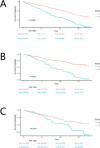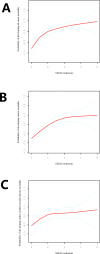Social determinants of health on all-cause and cause-specific mortality in US adults with chronic obstructive pulmonary disease: NHANES 2005-2018
- PMID: 40373096
- PMCID: PMC12080834
- DOI: 10.1371/journal.pone.0322654
Social determinants of health on all-cause and cause-specific mortality in US adults with chronic obstructive pulmonary disease: NHANES 2005-2018
Abstract
Background: Social determinants of health (SDoH) are nonmedical societal factors that influence health outcomes. However, their relationship with mortality risk in patients with chronic obstructive pulmonary disease (COPD) remains poorly understood. This study aimed to evaluate the association between SDoH and the risk of all-cause and cause-specific mortality in COPD patients.
Methods: Data from seven National Health and Nutrition Examination Survey (NHANES) cycles (2005-2018) were analyzed. Kaplan-Meier survival curves and multivariate Cox proportional hazards models were used to assess the association between SDoH and mortality outcomes, including all-cause and cause-specific mortality. The sensitive analyses were performed to check the robustness of the main findings. Nonlinear relationships were explored using restricted cubic spline (RCS) analysis, offering greater flexibility than traditional linear models. Subgroup analyses further assessed the consistency and robustness of findings across different demographic and clinical factors, enhancing the depth and reliability of the results.
Results: Among 1,551 COPD participants, 506 deaths occurred, including 114 from cardio-cerebrovascular diseases and 130 from cancer. Higher SDoH scores were inversely associated with survival outcomes. After adjusting for confounders, individuals with higher SDoH scores had increased risks of all-cause mortality (hazard ratio [HR] = 1.199, 95% confidence intervals [CI]:1.136, 1.264), cancer mortality (HR = 1.236, 95% CI: 1.100, 1.388), and cardio-cerebrovascular mortality (HR = 1.143, 95% CI: 1.022,1.277) compared to those with lower SDoH scores. Sensitivity analyses confirmed the positive correlations between SDoH and mortality in the COPD population. Kaplan-Meier analyses also revealed worse survival outcomes for participants with higher SDoH scores. The agreement between survival analyses and statistical modeling underscores the predictive value of SDoH in this population.
Conclusion: The results of our study indicate a notable positive correlation between SDoH score and the likelihood of mortality from all causes and specific causes in patients with COPD.
Copyright: © 2025 Ma et al. This is an open access article distributed under the terms of the Creative Commons Attribution License, which permits unrestricted use, distribution, and reproduction in any medium, provided the original author and source are credited.
Conflict of interest statement
The authors have declared that no competing interests exist.
Figures




References
MeSH terms
LinkOut - more resources
Full Text Sources
Medical

